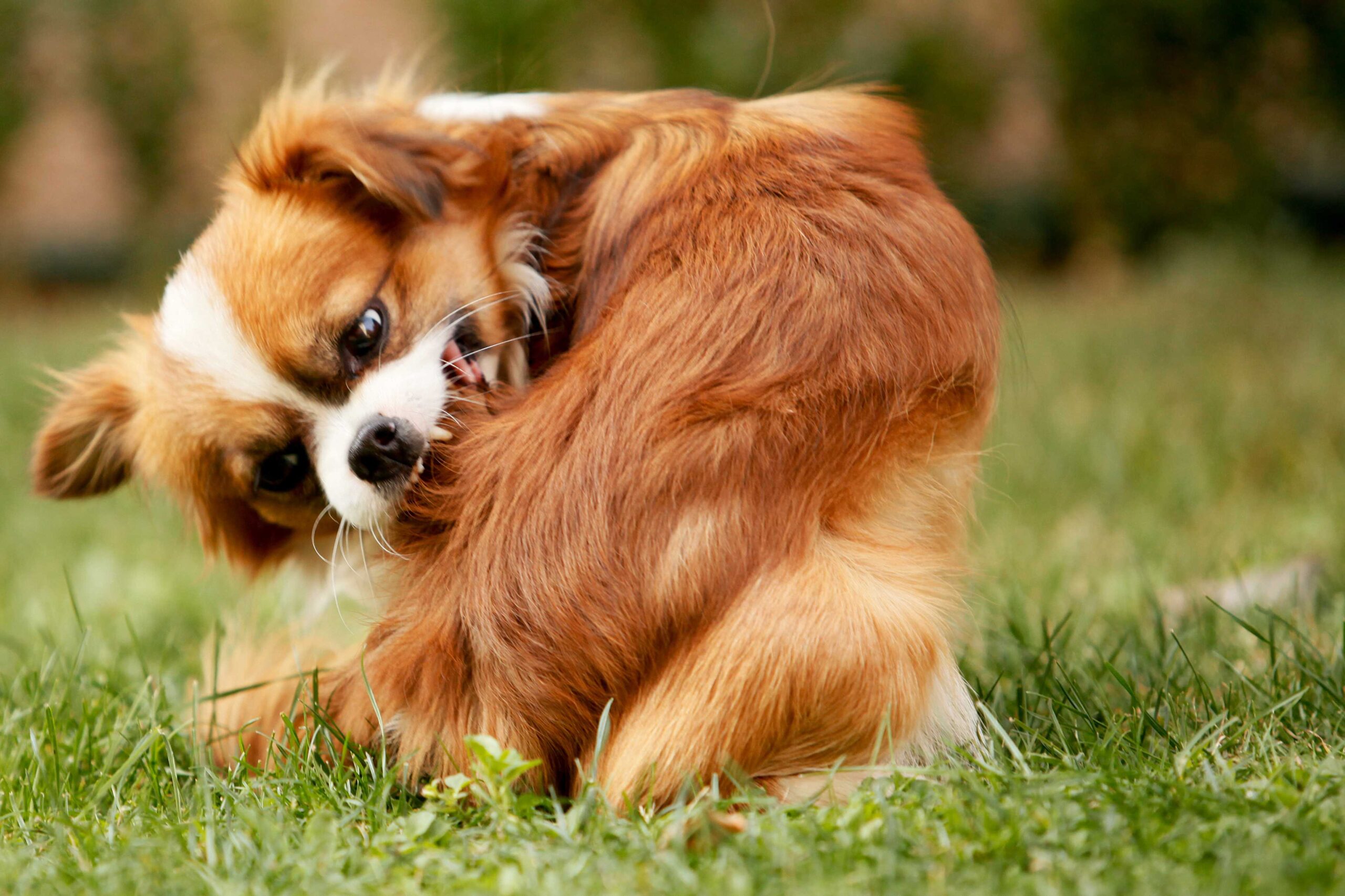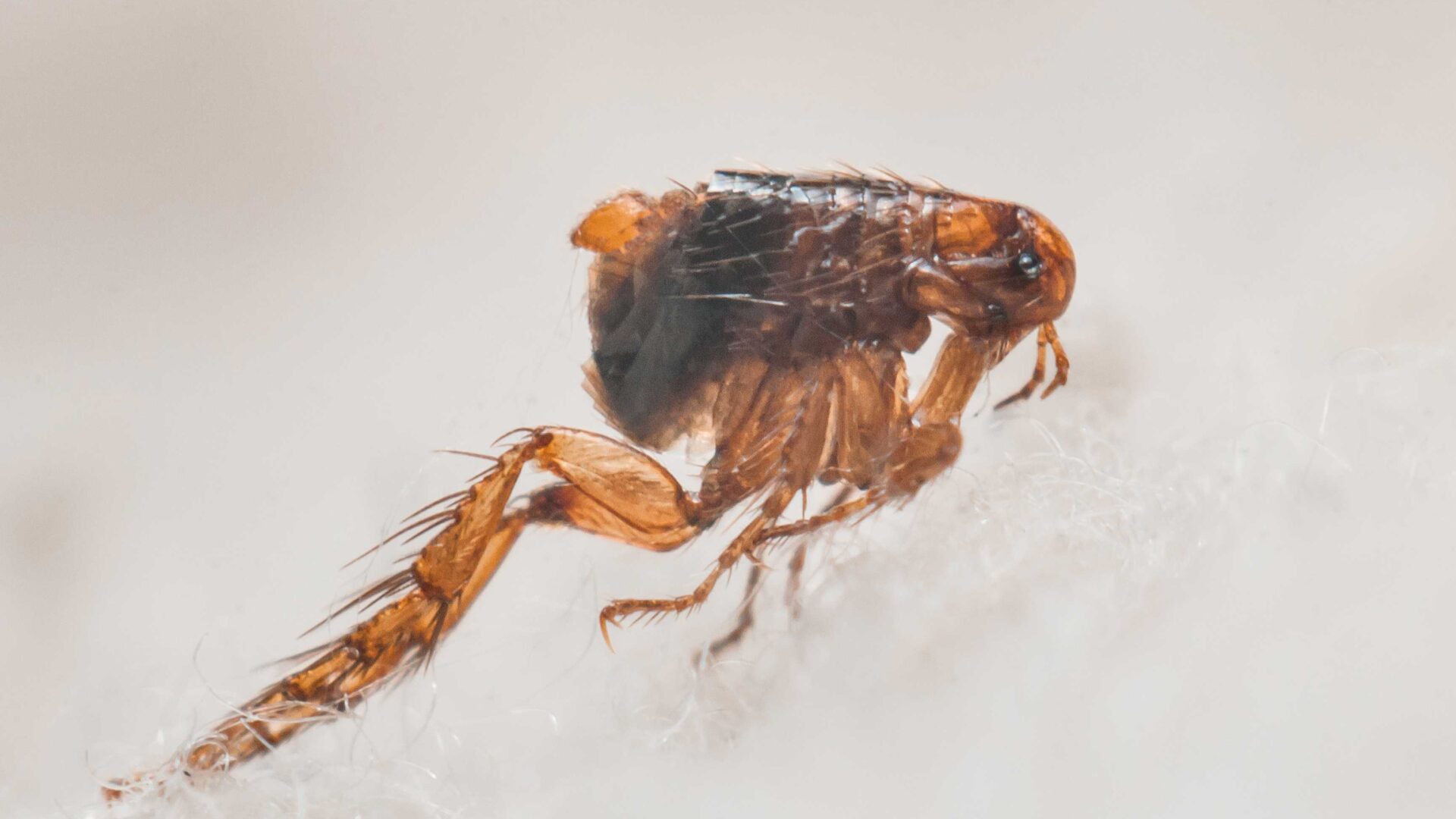Updated: 21/08/2024
Fleas are insects which feed on your dog’s blood, and dogs can get them from other animals or by visiting somewhere where fleas are present.
Fleas multiply rapidly and have a life cycle that involves both dogs and their surrounding environment.
They can cause a range of symptoms, from general discomfort and itching to skin infections and anaemia, and can play a role in infecting your dog with tapeworm, but not all dogs will show obvious signs of these infections.
Speak to your vet about anti-parasite treatments tailored to you, your pet and their environment
On this page:
- What are fleas?
- How can my dog get fleas
- Do fleas only live on our pets?
- What are the symptoms if my dog has fleas?
- What sort of health problems can fleas cause?
- How can I get rid of fleas?
- Using flea treatments safely
- How can I prevent my dog from getting fleas in the first place?
- Can I catch fleas from my dog?
What are fleas?
Fleas are small brown insects which feed on your dog’s blood by biting through the skin.
How can my dog get fleas?
Fleas can be picked up from other animals (pets or wildlife), or by visiting somewhere where there are fleas in the environment.
Do fleas only live on our pets?
The fleas you see on your pet tend to be the tip of the iceberg, and these horrible little critters multiply rapidly!
Only adult fleas are found on animals – flea eggs, larvae and pupae are found in the environment.
For our pets, this ‘environment’ often refers to our homes, and the early stages of the flea lifecycle will often reside in our dog’s bed, in carpets and under furniture.
So, if you do find adult fleas on your dog, you will need to treat your home as well as your pet to completely get rid of the problem.
If you have other dogs and cats at home, they will also need to be treated.
Veterinary Nurse Claire Kealey (RVN) says:
Seeing fleas on your pet can be so upsetting and trying to get rid of an infestation once they’re in your home is frustrating and costly. Speaking to a veterinary professional means you will get the best advice on products that will actually work.
What are the symptoms if my dog has fleas?
Most pets who have fleas will be itchy, however some pets (particularly cats) can have significant numbers of fleas without showing signs of scratching and discomfort.

When our pets scratch, this tends to be obvious, but you may also see signs such as the twitching of your pet’s coat along their back or them very suddenly turning to nibble at their sides.
If fleas are present, your pet’s skin may look pink and irritated. You may also notice sores or numerous small scabs throughout their coat.
It is possible to see fleas with the naked eye, although they are small and very fast!
What is flea dirt?
One thing you may notice more easily is the presence of flea dirt (flea poo) in your dog’s coat.
This looks like lots of very small black gritty bits (about the size of ground black pepper).
How obvious flea dirt is will depend on how many fleas your dog has, and it is often harder to spot on dogs with darker coats.
If you notice dark specks in your dog’s coat when grooming them and want to check whether you have found flea dirt, pop the specks on damp white tissue paper.
Flea dirt is actually flea poo and made up of dried blood. If you notice reddish brown staining on the tissue as the specks dissolve, it is very likely that your dog has fleas.
What sort of health problems can fleas cause?
Fleas are not just annoying for our pets; they can cause a range of health issues if left untreated.
Beyond general itching and discomfort, our pets may suffer from skin infections caused from constant licking and scratching.
Some pets also have a hypersensitivity to fleas, which means their bodies overreact to flea saliva causing an allergic response which can make them very, very itchy for days even from a single flea bite.
For small or vulnerable pets, large numbers of fleas can cause anaemia (a reduction in the number of red blood cells which carry oxygen around the body), and in extreme cases this can be life threatening.
Did you know? There’s also a link between fleas and tapeworms
The early stage of tapeworm (the larvae) can live in fleas. If our pet accidentally eats a flea when licking themselves, the tapeworm larvae can then grow into an adult tapeworm in our pet’s digestive system. Tapeworms can cause several issues for our pets, including an itchy bum, tummy upsets and weight loss.
How can I get rid of fleas?
What will my vet recommend?
Your vet will be able to advise on the best way to treat for fleas based on your dog’s individual situation and the level of infestation.
They will be able to advise on a tailored treatment plan considering the fleas’ lifecycle, the environment your dog lives in, whether your dog has any associated health problems and if there are any other pets at home who may also need to be treated.
They will recommend a suitable treatment for both your pet(s) and for the environment.
What can I do at home?
In addition to using treatments prescribed by your vet, there are several other things which may help.
Hot washing your dog’s bedding and vacuuming soft furnishings and carpets (paying attention to any nooks and crannies) can also help to reduce the flea population.
It’s also important to remember to empty your vacuum cleaner contents each time.
Using flea treatments safely
Ensure you always read the instructions carefully and never share products between different pets or different species without checking with your vet first, as some can potentially be harmful to other pets such as cats and rabbits if not used properly.
Some household flea sprays can also be dangerous to pet birds and fish, so always let your vet know what other pets you have at home and ask for advice about using a product if you aren’t sure.
How can I prevent my dog from getting fleas in the first place?
To prevent fleas, you can treat regularly with a reliable, good quality product.
In the long run this can be more cost effective than dealing with flea infestations and better for your dog’s health, but your vet can discuss what you need to consider with you.
Your vet will be able to advise you on the best way to protect your dog against fleas, considering your dog’s weight, current health, lifestyle and environment.
They will also be able to give advice on worm prevention and what products can be used safely together.
Can I catch fleas from my dog?
The species of flea that tend to live on our dogs aren’t the ones that can live on us for any length of time. However, it doesn’t stop them from giving us the occasional nasty bite!
Flea bites often look like tiny little red bumps on the skin (not dissimilar to gnat bites), and can vary in how itchy they are depending on the person who has been bitten.
Like our pets, some people are much more sensitive to flea bites than others.
If you have any skin lesions you are concerned about, then contact your doctor for advice.
If you need any help, have any questions, or are concerned that your dog has fleas, then please reach out to your local vets for further support.

